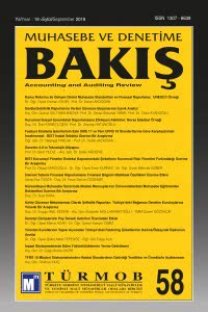HİLE ÜÇGENİ, HİLE ELMASI VE HİLE BEŞGENİ: HİLE EYLEMLERİNİN NEDENLERİNE İLİŞKİN TEORİLERE KAVRAMSAL BAKIŞ
hile, hile üçgeni, hile elması
FRAUD TRIANGLE, FRAUD DIAMOND AND FRAUD PENTAGON: A CONCEPTUAL OVERVIEW OF THE THEORY OF CAUSES OF FRAUD ACTIONS
Fraud, Fraud Triangle, Fraud Diamond,
___
- Abdullahi, R. and Mansor, N. (2015). Fraud Triangle Theory and Fraud Diamond Theory. Understanding the Convergent and Divergent For Future Research. International Journal of Academic Research in Accounting, Finance and Management Sciences, s.38-45.
- ACFE. (2020). https://www.acfe.com/report-to-the-nations/2020/
- Albrecht, C. (2009). International fraud: A management perspective. Ph.D. Dissertation Universitat Ramon Lull.
- Azam, M. R. (2008). Theory Application: Why People Commit Fraud. International Journal of Management, Accounting and Economics, s.54-66.
- Cieslewicz, J. (2012). The fraud model in international contexts: A call to include societallevel influences in the model. Journal of Forensic & Investigative Accounting.
- Donegan, J. and Ganon, M. (2008). Strain, differential association, and coercion: Insights from the criminology literature on causes of accountant’s misconduct. Accounting and the Public Interest, s.1-20.
- Dönmez, A. ve Çavuşoğlu, K. (2015). Hilelerin Ortaya Çıkarılması Bakımından Bağımsız Denetim İle Adli Muhasebenin Karşılaştırılmas. Journal of Accounting, Finance and Auditing Studies, s.34-67.
- Duffield, G. and Grabosky , P. (2001). The psychology of fraud. Trends and issues in crime and criminal justice. Australian Institute of Criminology.
- Erol, S. (2016). Hile Denetiminde Proaktif Yaklaşımlar. (Yayınlanmamış Yüksek Lisans Tezi) İstanbul Ticaret Üniversitesi. İstanbul.
- Gee, S. (2014). Fraud and Fraud Detection: A Data Analytics Apporoach. USA: Wiley.
- Holtfreter, K. (2004). Fraud in organization: An examination of control mechanism. Journal of Financial Crime, s.88-95.
- Huber, D. (2017). Forensic Accounting, Fraud Theory, and the End of the Fraud Triangle. Journal of Theoretical Accounting Research, s.28-48.
- J.T. , W. (2011). Corporate Fraud Handbook: Prevention and Detection. New Jersey: John Wiley & Sons Inc.
- Johnson, R. E., Silverman, S. B., Shyamsunder, A., Swee, H. Y., Rodopman, O. B., Cho, E. and Bauer, J. (2010). Acting superior but actually inferior?: Correlates and consequences of workplace arrogance. Human Performance, 23(5),s.403-427.
- Jonathan, M. (2009). Playing Offense in a High-Risk Environment. New York: Crowe Horwath.
- Karacan, S. ve Uygun, R. (2012). Denetim ve Raporlama. Kocaeli: Umuttepe Yayınları.
- Kassem, R. and Higson, A. (2012). The new fraud triangle model. Journal of Emerging Trends in Economics and Management Science, s.191-195.
- Köksal, İ. (2015). Dijital Ortamdaki Finansal Hile Kontrolünde Adli Muhasebe: Bağımsız Denetçiler Üzerinde Bir Araştırma. (Yayınlanmamış Yüksek Lisans Tezi). Dumlupınar Üniversitesi. Kütahya.
- Kranacher, M.-J. and Riley, R. (2020). Forensic Accounting and Fraud Examination. Wiley.
- Marks, J. (2020). https://boardandfraud.com/2020/05/21/fraud-pentagon-enhancements-to-the-fraud-triangle-and-under-which-fraud-may-occur/
- Mengi, B. T. (2012). Hile Denetiminde Yetkinliklerin Değerlendirilmesi-Hile Karosu. Mali Çözüm, s.113-128.
- Nanda, S., Zenita, R. and Salmiah, N. (2019). Fraudulent Financial Reporting: A Fraud Pentagon Analysis. Accounting and Finance Review, s.106-113.
- Nindito, M. (2018). Financial Statement Fraud: Perspective of the Pentagon Fraud Model in Indonesia. Academy of Accounting and Financial Studies Journal.
- Noble , M. (2019). Fraud Diomand Analysis in Detecting Financial Statement Fraud. The Indonesian Accounting Review, s.121-132. Özeroğlu, A. (2014). Finansal Aldatmaca ve İşletme Hileleri. Akademik Sosyal Araştırmalar Dergisi, s.180-196.
- Rae, K. and Subramaniam, N. (2008). Quality of internal control procedures: Antecedents and moderating effect on organisational justice and employee fraud. Managerial Auditing Journal, s.104-124.
- Silverman, S. B., Johnson, R. E., McConnell, N. and Carr, A. (2012). Arrogance: A formula for leadership failure. The Industrial-Organizational Psychologist, s.21-28.
- Sorunke and Abayomi, O. (2016). Personal ethics and fraudster motivation: The missing link in fraud triangle and fraud diamond theories. International Journal of Academic Research in Business and Social Sciences.
- Sujeewa , G., Yajid , M., Khatibi , A. and Azam , S. (2020). The Relevance of Fraud Diamond Theory in Determining Employee Frauds in Public Sector Entities in Sri Lanka. International Journal of Economics, Commerce and Management, s.15-25.
- Wolfe, D., and Hermanson, D. (2004). The fraud diamond: Considering the four elements of fraud. CPA Journal, s.38-42.
- Yaman, A. (2019). İşletmelerde Hile, Çalışanların Hile Algısı ve Etik Anlayışları Arasındaki İlişki. (Yayınlanmamış Yüksek Lisans Tezi). Beykent Üniversitesi. İstanbul.
- Yazıcı, N. (2018). Hile Üçgeni: Fırsatların Önlenmesinde Kırık Camlar Teorisi. Üçüncü Sektör Sosyal Ekonomi, s.843-851.
- Yendrawati, R., Aulia, H., and Prabo, H. (2019). Detecting the Likelihood of Fraudulent Financial Reporting: An Analysis of Fraud Diomand. Asia-Pacific Management Accounting Journal, s.43-69.
- Yusof, M., Ahmad, K., & Simon, J. (2015). Fraudulent financial reporting: An application of fraud models to malaysian public listed companies. The Macrotheme Review.
- ISSN: 1307-6639
- Yayın Aralığı: 3
- Başlangıç: 2000
- Yayıncı: TÜRMOB
Süleyman EMİR, Özlem Nilüfer KARATAŞ ARACI, Hakki KIYMIK
Mustafa KISAKÜREK, Feyzi YAŞAR, Seren AYDINGÜLÜ SAKALSIZ
MALİ MÜŞAVİR ADAYLARININ FİNANSAL OKURYAZARLIK TUTUM VE DAVRANIŞLARIYLA İLGİLİ BİR İNCELEME
ÜLKELERİN UFRS UYGULAMALARININ KABULÜNDE KÜLTÜRÜN ETKİLEYİCİ ROLÜ ÜZERİNE BİR ARAŞTIRMA
Fevzi Serkan ÖZDEMİR, İsmail Hakkı ÜNAL
YALIN MUHASEBE ARACI SKOR TABLOSU İLE DFMA’NIN FİNANSAL YARARLARININ ÖLÇÜLMESİ
ALTERNATİF PERFORMANS ÖLÇÜTLERİNİN GELECEĞİ VE DENETİMİ ÜZERİNE BİR DEĞERLENDİRME
